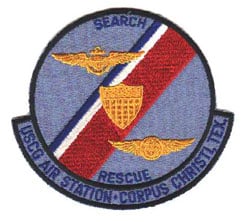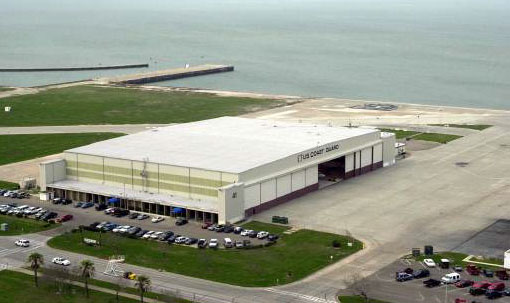 The Coast Guard Air Detachment Corpus Christi was established on 20 November 1950 as a tenant organization of the US Naval Air Station (NAS). NAS Corpus Christi is located in the Flour Bluff area, ten miles southeast of the city of Corpus Christi, Texas. The air detachment, with just one PBY-5A, four pilots and 11 enlisted crewmembers, provided search and rescue support in the western Gulf of Mexico, as well as the 350 miles of coastline and inland waterways in the Texas Coastal Bend area. By the mid 1950s the PBY had been replaced by the UF-1G and two additional aircraft were added. The detachment was formally designated an Air Station in the mid 1960s.
The Coast Guard Air Detachment Corpus Christi was established on 20 November 1950 as a tenant organization of the US Naval Air Station (NAS). NAS Corpus Christi is located in the Flour Bluff area, ten miles southeast of the city of Corpus Christi, Texas. The air detachment, with just one PBY-5A, four pilots and 11 enlisted crewmembers, provided search and rescue support in the western Gulf of Mexico, as well as the 350 miles of coastline and inland waterways in the Texas Coastal Bend area. By the mid 1950s the PBY had been replaced by the UF-1G and two additional aircraft were added. The detachment was formally designated an Air Station in the mid 1960s.
The primary mission remains search and rescue but, much like other aviation units in the Coast Guard, mission responsibilities diversified and increased throughout the years. Typical rescue missions include: searches for overdue boats, assisting disabled or sinking vessels; rescuing survivors; and medical or other evacuations from offshore oil rigs or vessels. Initially aids to navigation surveillance responsibilities were added and during the early stages of the maritime drug interdiction program Air Station Corpus Christi was very much involved in joint operations. They continue to remain so. In addition to local drug interdiction patrols, aircraft and crews are frequently deployed outside the South Texas waters. Federal fisheries law is enforced and marine environmental patrols are flown. HU-25B aircraft were used and equipped with a unique AIREYE surveillance system and were deployed nationally to track oil spills and plot winter ice flows.
In order to accomplish the expanded and newly assigned missions the UF-1G Albatross amphibians were upgraded to UF-2Gs, later designated HU-16E, and HH-52 helicopters arrived in the late 1960s This greatly increased the search and rescue capabilities of the air station. The aging HU-16s were temporarily replaced by HC-131 aircraft in 1977 and these were in turn replaced by the HU-25B in 1982. In the spring of 1986 the HH-52s were replaced by the HH-65A twin engine “Dolphin” helicopters. The HU-25Bs have now been retired.
To better address the operational responsibilities a Group concept was established and on 15 October 1980 the air station became one of thirteen group units between Port O’Connor, Texas and the Mexican border comprising Coast Guard Group Corpus Christi. The Air Station and the Group Office were located in hangar 41 at the Naval Air station. The Commander of Coast Guard Group Corpus Christi also served as the commanding officer of Coast Guard Air Station Corpus Christi. To better manage the sweeping changes that took place in the Coast Guard, Sector Corpus Christi was established in May of 2005 by joining all units within the area of Port Lavaca / Brownsville under one unified command.
Among the many missions handled by the Air station, search and rescue has always had the highest priority. Typical missions include searches for overdue vessels; assisting boats sinking, disabled or on fire; and medical evacuations from off-shore oil rigs and vessels. The station aircrews and aircraft frequently fly on missions other than search and rescue. These missions include environmental protection, federal fisheries law enforcement and drug interdiction. Air station aircraft and crews frequently deploy out of the South Texas area to work with other Coast Guard units on law enforcement missions.
During 2006, Sector Corpus Christi conducted over 450 search and rescue cases, assisted 591 people in distress, saved 83 lives, saved $3 million in property, seized over 5500 pounds of drugs and interdicted over 130 illegal immigrants.


